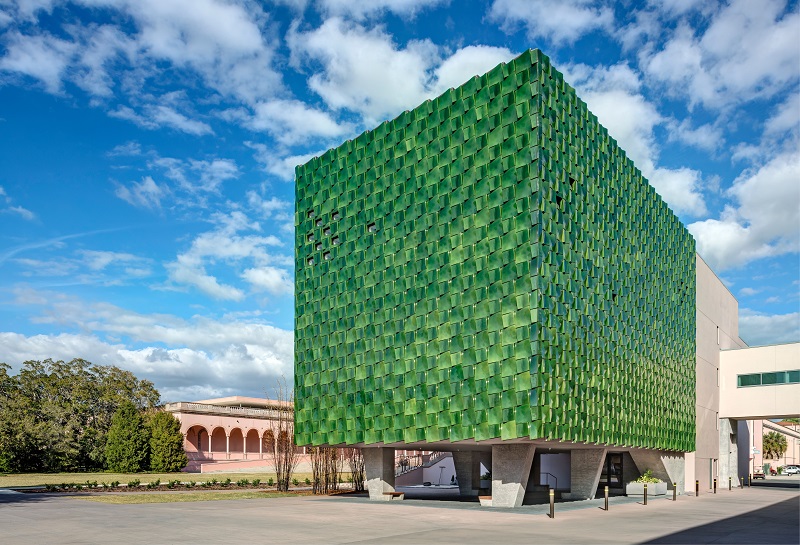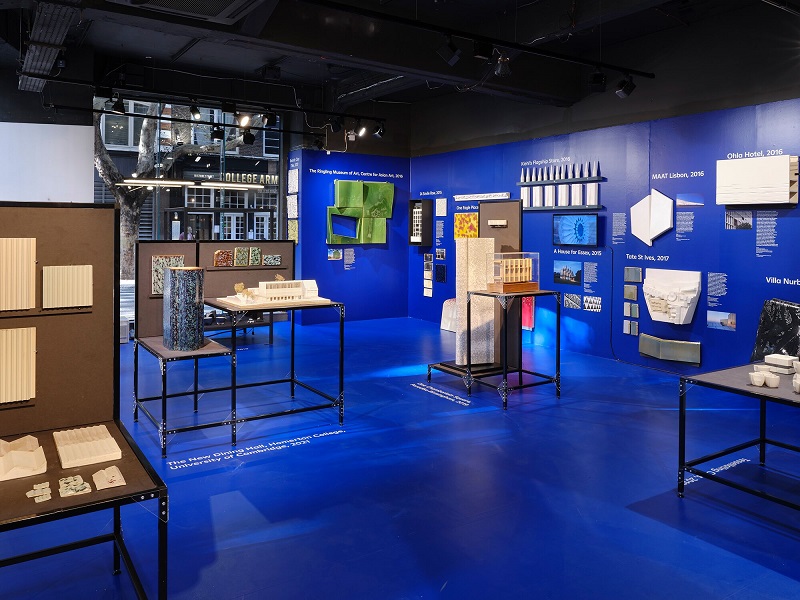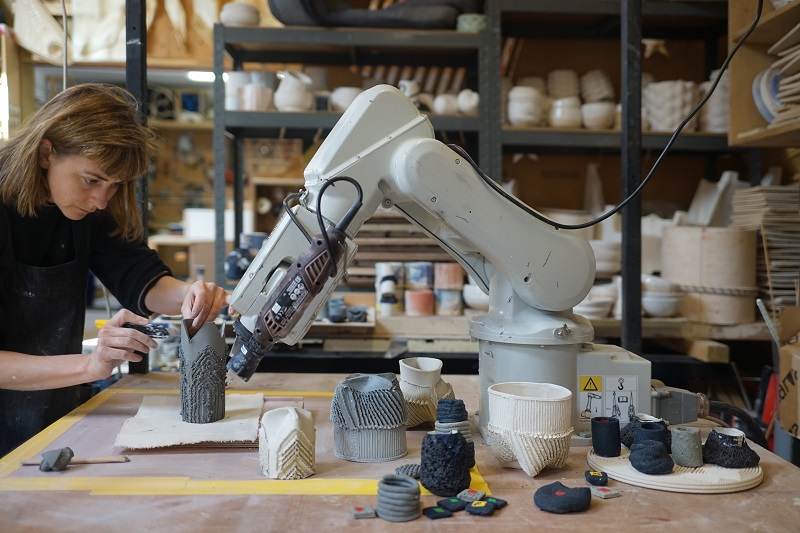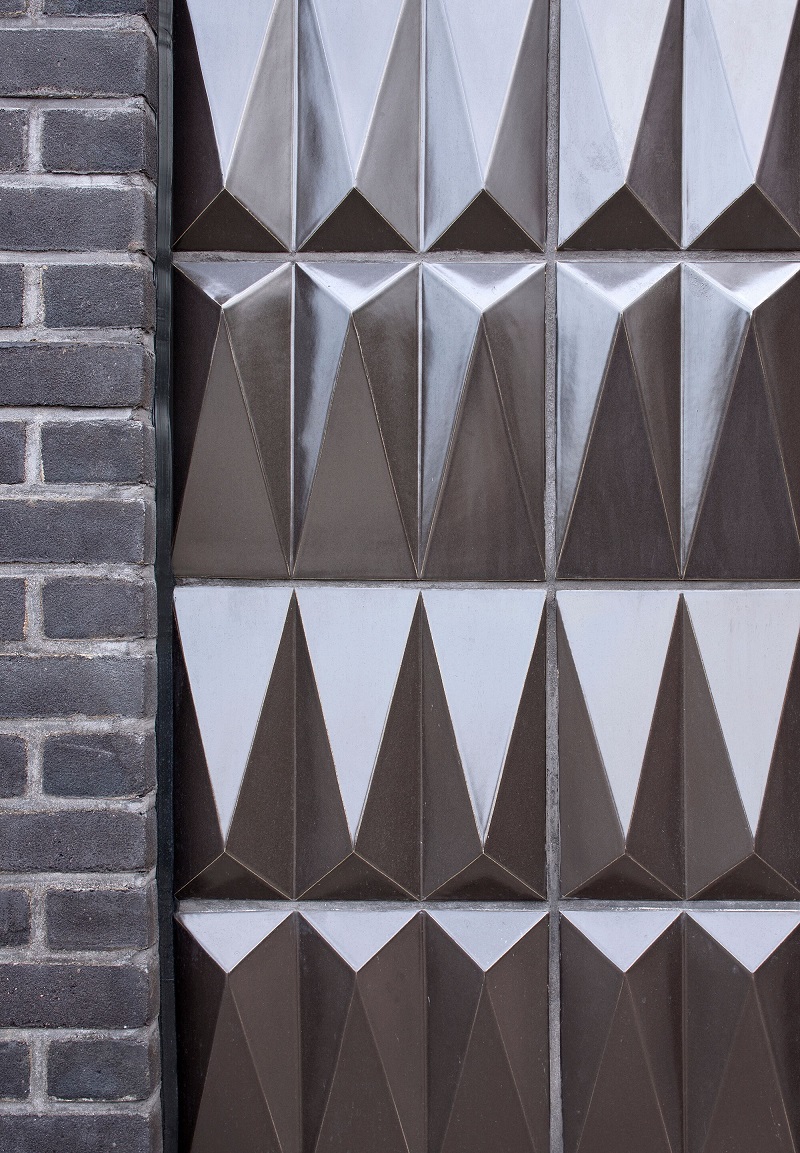Ceramics at The Building Centre

|
| The Ringling Museum of Art Centre for Asian Art, Boston Valley Terra Cotta, 2016. Machado Silvetti Architects. The new pavilion is clad in 3,000 jade-coloured glazed ceramic panels produced individually at the Boston Valley Terra Cotta facilities in Upstate New York, by RAM press, hand press and slip-cast forming methods, and installed on an aluminium track-and-clip system. Photo: Anton Grassi. |
Whether terracotta, faience, vitreous China, porcelain or other artefacts, ceramics have been used throughout history for both functional and decorative purposes. Their lasting appeal has also created a revival of interest in the past few years. So, it is timely that The Building Centre’s latest exhibition explores the role that ceramics play in contemporary architecture and focuses on the diversity of use – from hand-held objects to urban-scale interventions.
‘Hand Held to Super Scale’ tells the story of architectural ceramics, showcasing ground-breaking projects involving collaborations between architects, artists and makers. The show spans the entire gamut of ceramic usage, from glazed household items that inspire whole building facades to the manufacturers who use scaled-up processes familiar to studio potters. Showcasing traditional production methods with innovative technology adds dynamism to the event as hand-crafted pieces contrast with mass ceramic production and robotic arms.

|
| The exhibition brings together designers, artists, ceramicists, manufacturers and small-scale makers to show how contemporary ceramics are helping create inspiring spaces. The project explores the production of ceramics and creates a ‘tactile glossary’ so that visitors can learn through seeing and touching. Photo: John MacLean |
A major theme of the show is the architect-manufacturer-developer-ceramic artist collaborative partnerships that should be at the heart of projects and which are essential to push the boundaries in ceramic production. Practices and artists featured included Eric Parry Architects, Richard Deacon and Jamie Fobert, to more emerging talents such as Turner Prize-winning Assemble and Stirling Prize-nominated Feilden Fowles.

|
| Robotic arm. Photo: John MacLean |
One of the star features on display is the robotic arm created by researchers at Grymsdyke Farm for making clay constructions. Also of note are the innovative and creative schemes such as the bespoke tile production by Assemble; a sound installation made up of experimental ceramic surfaces by ECAlab; prototype elements for Homerton Hall by Feilden Fowles; façade samples from Penoyre & Prasad’s Brunel University building; iridescent tiles from the Stirling Prize nominated Tate St Ives by Jamie Fobert Architects; examples of the collaboration between Eric Parry and artist Richard Deacon for One Eagle Place, and work from seminal Spanish studio Ceràmica Cumella.
Jenny Watt, The Building Centre (co-curator of the exhibition) said: “We wanted to show how collaborations between artists, designers, manufacturers and studio potters can culminate in buildings that are full of beauty and craftmanship. But the show is not simply about decoration – we explore a mix between traditional and experimental manufacturing techniques, proving that the ancient craft of ceramics has a firm place in contemporary architecture.”
Lydia Johnson, Fettle Studio (co-curator of the exhibition) said: "I find it exciting to think that the coffee cup in your hand, the bathroom tiles on your wall, and the cladding on many ground-breaking buildings are made of the same stuff, and for the most part, in the same way. This fascinating parallel of one material through scale, allows the smallest of studio potters to experiment, and the largest of manufacturers to fabricate, in conversation with architects and designers, to bring the charm, character and personality of handmade ceramics into the big world of construction."
‘Hand Held to Super Scale’ is curated by the Building Centre and Fettle Studio, a ceramic studio led by architect Lydia Johnson.

|
| Haddo Yard, Denizen Works, 2017. This project includes bespoke tiles which reference the faience tiles throughout Whitstable, Kent. |
[edit] About The Building Centre
The Building Centre is a not-for-profit organisation dedicated to, ‘…providing education, information and inspiration to all sectors of the built environment as well as the general public’. It is located on South Crescent, 26 Store Street, London WC1E 7BT. Nearest tube station is Goodge Street (Northern Line).
[edit] Related articles on Designing Buildings Wiki
Featured articles and news
RTPI leader to become new CIOB Chief Executive Officer
Dr Victoria Hills MRTPI, FICE to take over after Caroline Gumble’s departure.
Social and affordable housing, a long term plan for delivery
The “Delivering a Decade of Renewal for Social and Affordable Housing” strategy sets out future path.
A change to adoptive architecture
Effects of global weather warming on architectural detailing, material choice and human interaction.
The proposed publicly owned and backed subsidiary of Homes England, to facilitate new homes.
How big is the problem and what can we do to mitigate the effects?
Overheating guidance and tools for building designers
A number of cool guides to help with the heat.
The UK's Modern Industrial Strategy: A 10 year plan
Previous consultation criticism, current key elements and general support with some persisting reservations.
Building Safety Regulator reforms
New roles, new staff and a new fast track service pave the way for a single construction regulator.
Architectural Technologist CPDs and Communications
CIAT CPD… and how you can do it!
Cooling centres and cool spaces
Managing extreme heat in cities by directing the public to places for heat stress relief and water sources.
Winter gardens: A brief history and warm variations
Extending the season with glass in different forms and terms.
Restoring Great Yarmouth's Winter Gardens
Transforming one of the least sustainable constructions imaginable.
Construction Skills Mission Board launch sector drive
Newly formed government and industry collaboration set strategy for recruiting an additional 100,000 construction workers a year.
New Architects Code comes into effect in September 2025
ARB Architects Code of Conduct and Practice available with ongoing consultation regarding guidance.
Welsh Skills Body (Medr) launches ambitious plan
The new skills body brings together funding and regulation of tertiary education and research for the devolved nation.
Paul Gandy FCIOB announced as next CIOB President
Former Tilbury Douglas CEO takes helm.
UK Infrastructure: A 10 Year Strategy. In brief with reactions
With the National Infrastructure and Service Transformation Authority (NISTA).






















